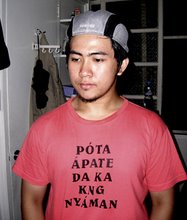By Robby Tantingco
Peanut Gallery
As discussed a previous column, the Pampanga Province that Spain created in the early days of colonization occupied practically the entire midsection of Luzon; it was one of the island's first three mega-provinces, the other two being Ilocos (occupying Northern Luzon) and Manila (occupying Southern Luzon, including Bicol).
Much of the huge Pampanga Province was hinterland -- forests and swamplands and rice fields -- with only pockets of settlements along the rivers Rio Grande and Rio Chico, as well as along the ancient roads to Pangasinan.
And not all inhabitants spoke Kapampangan; the Kapampangan- speaking areas were most likely concentrated on the communities on the riverbanks; the rest were tribal groups, including the much-feared headhunters.
Over the years, Pampanga's boundaries expanded and contracted depending on how many haciendas were awarded to Spanish officials, how many encomiendas were assigned for tax collection and how many new missions were created by Spanish missionaries. At one point, the boundaries extended all the way to Palanan, Isabela in the north and to Infanta, Quezon in the south, with the Pacific Ocean on its east side and the China Sea on its west side.
Eventually, the Spaniards realized that it was difficult to govern such a huge province from one provincial capital way down south in Bacolor, and they began cutting it up into commandancias or military outposts which later evolved into new provinces.
First to go was Nueva Ecija. When it was created in 1704 as the Commandancia Politico-Militar de Nueva Ecija (named after the governor general's hometown of Ecija in Andalucia, Spain), it included parts of Bulacan and the Candaba Swamp, Paniqui and Barug (now Gerona), Nueva Vizcaya, Palanan in Isabela, Infanta, the Polillo Islands and Kalilaya (which later became the province of Tayabas, renamed Principe, renamed Quezon, renamed Aurora).
As commandancia, Nueva Ecija remained administratively under Pampanga until it became a province in 1848. By that time, Nueva Ecija had shrunk in size so much that Pampanga had to give up some of its own towns to firm up the new province. These towns were Cabiao, San Antonio, Gapan, San Isidro and Aliaga -- today under the political sphere of Nueva Ecija but still Kapampangan- speaking.
In 1839, it was Nueva Vizcaya's turn to become a commandancia, followed by Principe (Quezon) in 1853, Isabela in 1856 and Tarlac in 1860.
Tarlac initially included Bamban, Capas, Concepcion, O'Donnell, Tarlac and Victoria, as well as Camiling, Gerona, Moncada and Paniqui (which were annexed from Pangasinan, which is why residents in these four towns hardly speak Kapampangan) .
Tarlac also included four towns from Pampanga: Floridablanca, Mabalacat, Magalang and Porac. When Tarlac became a province 13 years later, in 1873, these four towns were reverted to Pampanga.
Meanwhile, Bataan was initially divided into two sections: the towns that were part of Pampanga (Orion, Pilar, Balanga, Abucay, Samal, Orani, Hermosa and Dinalupihan) , and the corregimiento (similar to commandancia) of Mariveles, which included Bagac, Morong and Maragondon (Cavite). Although Bataan became a province early on, in 1754, most of the original Pampanga towns have continued to speak Kapampangan. Bataan's northern neighbor, Zambales, used to be quite accessible from Pampanga through ancient trails and passes cutting through the Zambales Mountain Range.
The town of Botolan was in fact founded by a Kapampangan from Mabalacat in 1819, while the capital town of Iba came from the Kapampangan word iba ("earthenware" ). Bataan's capital town, Balanga, likewise came from a Kapampangan word. The ancient mountain trails were still quite serviceable until 1991, when Mount Pinatubo's eruption buried them. The government today should consider unearthing and rehabilitating these trails to cut down the number of hours it takes to reach the other side.
As for Bulacan, historians disagree on a lot of things. First, they disagree on where the name came from: some say from the Kapampangan word burak, because the place was swampy and muddy, while others say from the word bulak, since the road to the capital town was once upon a time lined with rows of cotton trees.
Second point of disagreement is the year it became a province: one document says 1578, but most other documents say Pampanga covered practically everything between Manila and Ilocos; even Tondo (from the Kapampangan word tundun) inhabitants spoke Kapampangan.
Today, many places in Bulacan bear Kapampangan names. Even Bulaqueños themselves do not understand them, and have sometimes resorted to wild explanations. For example, residents of a barrio called King Kabayo in San Miguel, Bulacan think it has something to do with a royal horse, while those living in Quingua (Plaridel) think it's a Chinese word. (Actually they're both Kapampangan words: king is a preposition that means "in" or "at" while quingua or kingwa is a verb that means "acquired.") Similarly, some folks believe that barrio Batasan on the border with Candaba came from Batasan Pambansa, but it's actually the Kapampangan word for "shortcut."
Other places in Bulacan with Kapampangan names include barrios Kapitangan, Longos, Calumpang and Iba in Hagonoy; Pinaod, Biclat and Makapilapil in San Ildefonso; Mayumu, Ilug Bulo and Cabio in San Miguel; Masukol and Binakod in Paombong; Dalig, Batin and Balagtas in Balagtas town; Penabatan and Inaon in Pulilan; Taliptip and Bambang in Bulacan town; and Talaksan in San Rafael.
Today, all that has remained of Pampanga is the heart-shaped province at the mouth of the Pampanga River near Manila Bay. This is the administrative territory that has been defined by political leaders. But the real Kapampangan- speaking region still encompasses areas beyond the borders, in Tarlac, Bulacan, Nueva Ecija and Bataan.
To our kabalen living in those provinces: Remember that the only thing that separates you from the rest of us is an imaginary line that is visible only in maps. You are, and will always be, Kapampangans at heart.
Alben meng manyaman, boy!
Subscribe to:
Post Comments (Atom)








1 comment:
Do you know what does the term Morong means in Kapampangan?,because I am curious about the meaning of Morong because two places have that name Morong,Rizal and Morong,Bataan....
Post a Comment